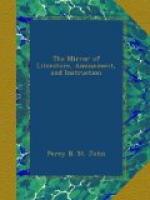and lower orifices are bound fast with a strong thread,
and the stomach being thus tied, be cut above and
under the ligature, and afterwards pressed with both
hands, so as to make all that it contains pass on
one side, and to produce a swelling on that part which
contains the incision, which must be held with the
left hand, to prevent the inflammable air escaping.
This hand being removed, and a candle applied about
an inch from the stomach, a blueish flame will issue,
which will last nearly a minute. The circumstances
of the case of Grace Pitt, to which your Correspondent
refers, perfectly coincide with the foregoing remarks.
She was accustomed for several years to go down stairs
after she was undressed, to
smoke a pipe.
Her daughter, who slept with her, did not miss her
till the morning, when on going down stairs, she found
her mother’s body extended
over the hearth,
and appearing like a block of wood burning with a
glowing fire, without flame. She was, no doubt,
in the act of lighting her pipe, either at the fire
or candle, and the breath issuing from her mouth during
respiration, being impregnated with the spirits she
had lately drunk, caught fire, and communicated with
the animal substance, also impregnated with spirit,
and thus the body was destroyed. Indeed, in nearly
all the cases of this nature reported, the bodies
have been found on the hearth, or the persons have
been left with a candle near them. The combustion
of the human body in these cases is generally entirely
inward, and it is very seldom that any of the contiguous
articles are destroyed. In the instance mentioned
above, a child’s clothes on one side of the woman,
and a paper screen were untouched, and the deal floor
on which she lay was not even discoloured.
The most remarkable instance of this nature on record,
is that of the Countess Cornelia Bandi; she was in
the sixty-second year of her age, and on the day before
well as usual. After she was in bed she conversed
with her maid for two or three hours, and then fell
asleep. The servant on going into her chamber
in the morning, saw her lady’s two feet distant
from the bed, a heap of ashes, and two legs with the
stockings on. Between the latter was part of
the head, but the brains, half the skull, and the
chin, were burnt to ashes, which, when taken up in
the hand, left a greasy and offensive moisture.
The bed received no damage, and the clothes were elevated
on one side, as by a person rising from beneath them.
She appears to have been burnt standing, from the skull
being found between her legs; the back was damaged
more than the front of the head, partly because of
the hair, and partly because in the face there were
several openings, out of which the flames are likely
to have issued. In this account it is not stated
either that she was of intemperate habits, or that
a candle was left in the room with her; but the latter
is very likely, she being advanced in years; and it
may be conjectured, that in rising from her bed, she
caught fire.




